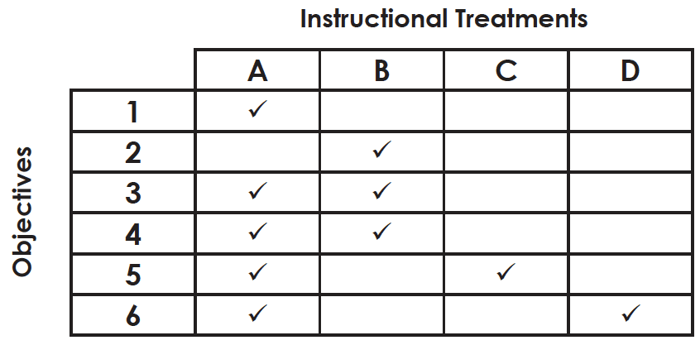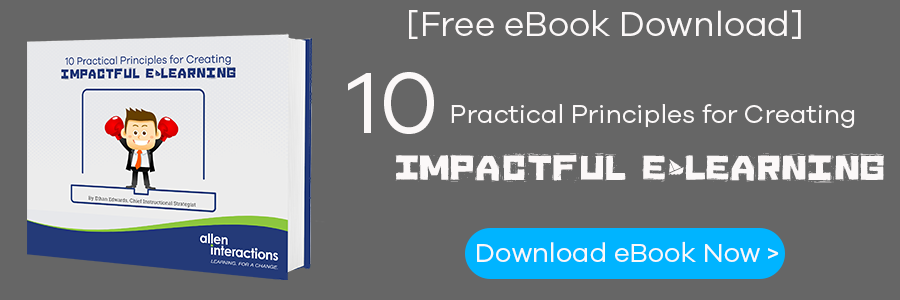Blog
My eLearning Hopes for 2017
By Michael Allen, Chairman & CEO, Allen Interactions Instructional design determines the effectiveness of training. In all of my presentations, ...


Tips for Faster, Easier, Better eLearning Design
By Michael Allen | March 02, 2017 | Custom Learning | 0 Comments
By Michael Allen, Chairman & CEO, Allen Interactions
 Instructional design determines the effectiveness of training. In all of my presentations, demonstrations, books, and webinars, I contrast what can be achieved through great design with what is so often not achieved because basic design principles were not applied. But I know that instructional design takes time and effort in addition to knowledge and skill. There’s a cost—a cost many organizations try to avoid, regardless of the consequences.
Instructional design determines the effectiveness of training. In all of my presentations, demonstrations, books, and webinars, I contrast what can be achieved through great design with what is so often not achieved because basic design principles were not applied. But I know that instructional design takes time and effort in addition to knowledge and skill. There’s a cost—a cost many organizations try to avoid, regardless of the consequences.
Today, I’m going to avoid the temptation to rant on why one would minimize the relatively small costs of good instructional design only to pay far more through missed opportunities, wasted employee time, and hits to morale and motivation. Rather, I’m asking…
How can ID costs be reduced without paying all the penalties that result from poor design?
Objectives x Treatments Matrix
An indispensable for instructional design is an objectives x treatments matrix. It’s a simple concept that not only minimizes time and effort, but helps lead the overall design process. It simultaneously addresses time, cost, and quality. Here is how it’s done:
First, list instructional objectives. While I know writing instructional objects seems “old hat” and tedious, objectives really help focus efforts and curb tendencies to go off track. It’s quite easy in design to become excited about producing a fun learning experience for a minor slice of content and put a lot of effort into it, only to have too little time and resources left for more important and perhaps difficult-to-teach skills. Listing objectives provides a valuable perspective and itemized list of design tasks.
 Second, sketch an instructional treatment for the first objective, being careful as always to define the CCAF components (context, challenge, activity, and feedback). Visualizing the learning event via sketching can be done quickly. This is not a test of drawing or artistic talent; rough is good, as we want to minimize time and effort here. Later revisions are inevitable (and smart).
Second, sketch an instructional treatment for the first objective, being careful as always to define the CCAF components (context, challenge, activity, and feedback). Visualizing the learning event via sketching can be done quickly. This is not a test of drawing or artistic talent; rough is good, as we want to minimize time and effort here. Later revisions are inevitable (and smart).
Third, repeat with the second objective, but this time ask whether the first instructional treatment would be a good approach for this objective as well. If it is, just mark the same treatment for reuse here and move on. If not, decide whether to identify a new treatment or modify the first one to be appropriate for both objectives.
As you work through the objectives, consider using two or more treatments for some objectives where previously defined treatments are applicable but insufficient. You might be able to find a set that work well and provide additional flexibility for covering other objectives as a bonus.
Example
An emerging matrix might look like this with objectives and treatments defined in the following table:

Objectives Treatments
| Observable Behavior | Context | Activity |
| 1. Clear pool area for safety and proper cleaning. |
On site, at a variety of pools: Some situations show hazards (such as children playing nearby, gardeners at work, or party preparations with electrical devices near water) and typical obstacles to cleaning (chairs, tables, glasses, etc.). |
(A) Target identification and classification: Find all items of concern and match with appropriate remedy. |
| 2. Test pool water. | Provided: a basic residential sanitizer residual and pH testing kit with color-coded directions for testing DPD chlorine (.5–5 ppm), DPD bromine (1–10 ppm) and pH (6.8–8.2). Pools have normal and abnormal water conditions. | (B) Sequential task completion: Procedural activity simulation for common errors in processes with delayed feedback. Learners must perform test steps in proper order and report correct results. |
| 3. Examine water filter. Clean or replace. | Different types of filters (sand, D.E., or cartridge) and filter conditions (normal, damaged, spent). |
(A) Target identification and classification: Find all items of concern and match with appropriate remedy. (B) Remedy: Sequential task completion. |
| 4. Clean pool. | Pools with varying states of debris, tile calcification, and water clarity. |
(A) Target identification and classification. (B) Sequential task completion. |
| 5. Clean site. | Pool areas previously shown for objective #1 after cleaning with both service equipment and customer property in likely places. |
(A) Target identification. (C) Drag and drop positioning: Place objects in original positions, safe positions, or truck as appropriate. |
| 6. Complete service ticket. | Completed forms corresponding to performed service but with errors. |
(A) Target identification. (D) Text entry correction. |
Rapid Prototyping
I’m a strong proponent of rapid prototyping. Prototypes flush out ideas and help reach consensus faster and more effectively than any other process. You might wonder when to prototype and when to construct an objectives x treatments matrix. Do you need to do both?
Yes, both, but perhaps in an order reversed from what you’d expect. Instead of listing the objectives, defining treatments, and then prototyping treatments, which can work, try prototyping first. I suggest this because prototyping seems to both stimulate creativity and help people define what their training objectives really should be. It’s a fast method of getting to the crux of the need and defining clever ways to help learners build skills.
Prototyping and matrix development can be interleaved. If some objectives have been defined first, you can begin prototyping a treatment for the first one. The outcome can be very instructive. Keeping an open mind, you might decide the objective isn’t quite right or needs to be preceded by other objectives. It’s likely you’ll identify missing objectives as well as clusters of objectives that should be combined.
Try It
The process is far faster and more accurate than creating a design specifications document. When done as a team effort, it helps everyone understand what’s going to be done and why. It’s so much better than trying to verbally describe the final product with the specificity needed to prevent variance in interpretation. And by constantly looking out for opportunities to create treatments that have multiple uses, the approach minimizes instructional design time and effort while creating consistency across the learning experiences that learners will appreciate.
LIKE WHAT YOU'VE READ? SHARE THE KNOWLEDGE WITH THIS READY-MADE TWEET!
CLICK TO TWEET: #Tips for Faster, Easier, Better #eLearning Design https://ctt.ec/LpBc1+ by @customelearning

About the Author: Michael Allen
Go to https://www.alleninteractions.com/bio/dr-michael-allen Michael W. Allen, PhD, has been a pioneer in the e-learning industry since 1970. For decades, Allen has concentrated on defining unique methods of instructional design and development that provide meaningful, memorable, and motivational learning experiences through enhanced cognitive interactivity. He developed the advanced design and development approaches we have used at Allen Interactions for the past three decades, including CCAF-based design and the SAM process for iterative, collaborative development. Michael is a prolific writer, sought-after conference speaker, and recognized industry leader, having written or edited nine books on designing effective e-learning solutions, including his latest edition: Michael Allen’s Guide to e-Learning. He has contributed chapters to textbooks and handbooks published by leading authors and associations.
Comments
Would you like to leave a comment?
Related Blog Posts

By: Michael Allen | Jan, 2017
Category: Custom Learning, Strategic Consulting
.png?width=316&name=2023%20Blog%20Covers%20and%20In-Line%20Graphics%20(59).png)
Blog
Instructional Design 3.0: Designing the Learner’s Journey - Part 4: ...
By Michael Allen, Chairman & CEO, Allen Interactions Instructional design determines the effectiveness of training. In all of my presentations, ...
By: Michael Allen | Dec, 2022
Category: Custom Learning, Dr. Michael Allen

Blog
Moving from Instructional Design —> Learning Experience Design
By Michael Allen, Chairman & CEO, Allen Interactions Instructional design determines the effectiveness of training. In all of my presentations, ...
By: Michael Allen | Jun, 2020
Category: Custom Learning, Strategic Consulting

